SpringMVC之RequestMapping执行过程(HandlerMapping下篇)
写在前面
在上篇中 回顾 here,我们已经介绍了 HandlerMethod 是如何被 自动扫描 出来,并注册到 RequestMappingHandlerMapping 中去的。
本文将延续上一篇,探究当一个请求 HttpServletRequest 到来,SpringMVC 又是如何 匹配获取 到合适的 HandlerMethod 的?
本文还是使用的上篇中的单元测试进行调试和分析的,有需要的可以到 Gitee here 上下载源码。
getHandler 时序图
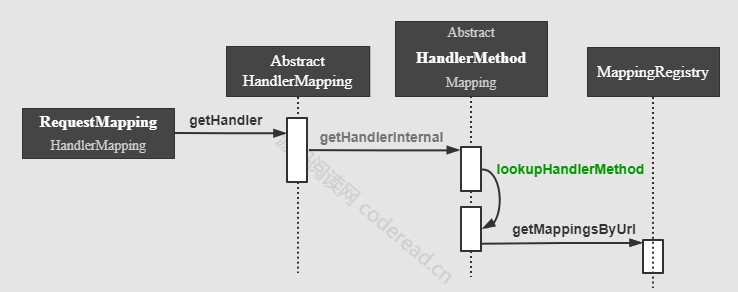
在这张时序图中,最重要的一段方法就是 lookupHandlerMethod。接下来,对该方法逐段进行分析。
1.getMappingByUrl
getMappingByUrl 是在 lookupHandlerMethod 中调用的第一个方法。
方法功能:根据 url 路径,获取可能与之匹配的 RequestMappingInfo 列表
源码:
urlLookup 的实例是 LinkedMultiValueMap:
LinkedMultiValueMap 是 LinkedHashMap + LinkedList 的组合数据结构。
向 LinkedMultiValueMap 添加的地方也仅有一处:
源码:
在注册时,需要调用 getDirectUrls 从 ReuqestMappingInfo 对象中提取作为索引 key 的 url 字符串。
1.1.getDirectUrls
源码:
getDirectUrls 里面有两个让人在意的点:
-
一个是 getPathMatcher() 返回一个什么样的对象?
-
另一个是 getMappingPathPatterns 得到了怎样的集合?
1.2.AntPathMatcher
首先回答第一个问题:getPathMatcher() 返回一个什么样的对象?
答案:getPathMatcher() 默认返回的是 AntPathMatcher。
尽管可以自定义 PathMatcher 接口,但是 AntPathMatcher 还是比较常用的。Apache Ant 的官方指南 here
AntPathMatcher 实现的是 Ant 风格的路径匹配(Ant-style path patterns),遵循的 URL 匹配规则如下:
-
?匹配一个字符 -
*匹配 >= 0 个字符 -
**匹配 >= 0 个目录 -
特别地,
{url:[a-z]+}表示路径变量 url 符合正则表达式[a-z]+
isPattern 源码:
看到 isPattern 这段代码,我们就可以明白 getDirectUrls 希望获得 不含通配符 的 url,这也就是 direct url 的第一层含义。
1.3.getMappingPathPatterns
接着回答第二个问题:getMappingPathPatterns 得到了怎样的集合?
答案:返回 Controller 类上作用于类的 @RequestMapping 注解和 Controller 类中方法上的作用于方法的 @RequestMapping 注解的结合。
追问1:为什么 RequestMapping 既可以是作用于类的注解,又可以是作用于方法的注解?
奥秘就在于 RequestMapping 注解类上面 @Target 注解的作用目标的声明。
追问2:为什么 getMappingPathPatterns() 能获取的是一个集合,而不是单个 url 呢?
答案:因为 @RequestMapping 的 value (别名 path)是 String[]
因此像这样的组合写法也是合法的。
@Controller
@RequestMapping({"/user", "/customer"})
public class UserController {
@RequestMapping({"/info","/detail"})
public ModelAndView user(String name, int age) {
System.out.println("name=" + name);
System.out.println("age=" + age);
return null;
}
}
此时,可以匹配的 url 有 4 个:
追问3:isPattern 没有排除 ${pathVariable} 的写法,那是不是表示 PathVariable 也算是 direct url 呢?
答案: PathVariable 也算是 direct url。
我们稍稍改变一下 UserController:
@Controller
@RequestMapping({"/user", "/customer"})
public class UserController {
@RequestMapping("${name}")
public ModelAndView user(@PathVariable String name, int age) {
System.out.println("name=" + name);
System.out.println("age=" + age);
return null;
}
}
这种情况下,getDirectUrls 就会返回 ["/user/${name}", "/customer/${name}"] 字符串数组。
2.addMatchingMappings
我们知道 url 仅仅是一个索引,假如我们调用 getDirectUrls 能获取到结果,就意味着“命中索引”,效率就会高很多。
否则就只能“全表搜索”了,效率就会低很多。
来看一下源码:
但是,无论是哪种方式,都会调用 addMatchingMappings。时序图如下:
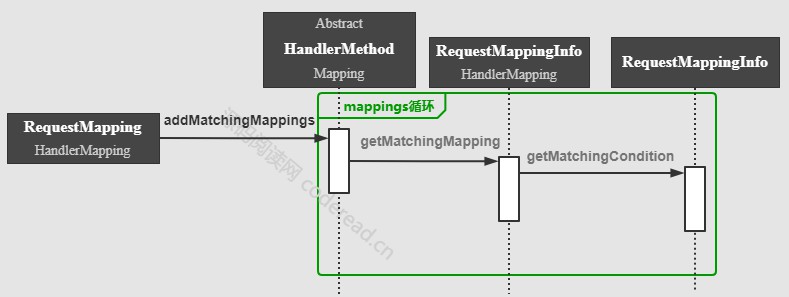
addMatchingMappings 方法中,foreach 遍历第一个参数——— RequestMappingInfo 集合 mappings。
-
getMatchingMapping:如果 RequestMappingInfo 和 HttpServletRequest 可以匹配,就返回一个新的 RequestMappingInfo对象,否则返回 null
-
getMatchingCondition:对 method,参数,请求头,consumes,produces,url patterns 等进行逐个匹配,假如有不匹配的,就返回 null。如果都能通过条件匹配,就返回一个新的 RequestMappingInfo对象。
getMatchingCondition 匹配规则比较复杂,涉及的类也还有很多,就不在本文展开了。
addMatchingMappings 方法中,每找到一个与 HttpServletRequest 匹配的 RequestMappingInfo,就会向参数 List<Match> matches 中加入一个 Match
Match 是由 RequestMappingInfo 以及对应的 HandlerMethod 组成。
3.对 Match 列表排序
现在继续回到 lookupHandlerMethod 方法。
既然,现在符合条件的 List<Match> matches 已经全部找出,我们就要排序并且筛选出最符合条件的 Match 了。
其中,最佳匹配对象 Match,它的 HandlerMethod 就是最佳 HandlerMethod。
总结
对于 RequestMappingHandlerMapping 而言,getHandler 就是要找一个最最匹配的 HandlerMethod 对象。
这个寻找最佳匹配 HandlerMethod 的逻辑就“藏”在 lookupHandlerMethod 中,主要步骤如下:
-
第一步,用请求的 url 路径获取 RequestMappingInfo 列表(“url索引匹配”);若匹配不上,只能全量遍历所有 RequestMappingInfo。
-
第二步,完全匹配 RequestMappingInfo 和 HttpServletRequest。匹配逻辑在 RequestMappingInfo#getMatchingCondition 中。
-
第三步,对匹配结果 Match 排序,选出最佳的 HandlerMethod,排序比较的逻辑在 RequestMappingInfo#compareTo 中。

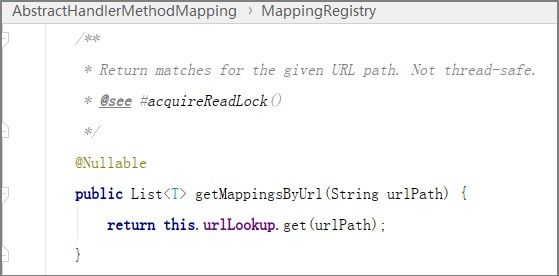




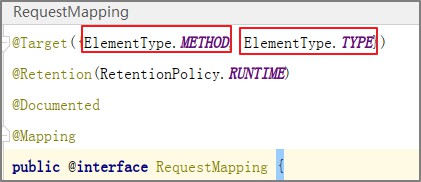

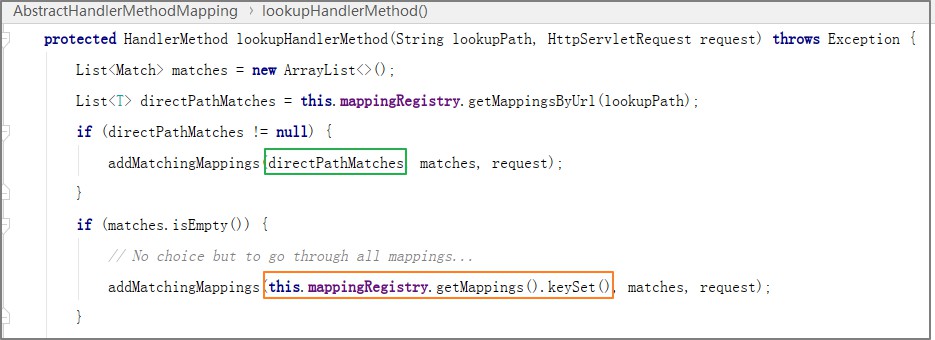


【推荐】国内首个AI IDE,深度理解中文开发场景,立即下载体验Trae
【推荐】编程新体验,更懂你的AI,立即体验豆包MarsCode编程助手
【推荐】抖音旗下AI助手豆包,你的智能百科全书,全免费不限次数
【推荐】轻量又高性能的 SSH 工具 IShell:AI 加持,快人一步
· 开发者必知的日志记录最佳实践
· SQL Server 2025 AI相关能力初探
· Linux系列:如何用 C#调用 C方法造成内存泄露
· AI与.NET技术实操系列(二):开始使用ML.NET
· 记一次.NET内存居高不下排查解决与启示
· Manus重磅发布:全球首款通用AI代理技术深度解析与实战指南
· 被坑几百块钱后,我竟然真的恢复了删除的微信聊天记录!
· 没有Manus邀请码?试试免邀请码的MGX或者开源的OpenManus吧
· 园子的第一款AI主题卫衣上架——"HELLO! HOW CAN I ASSIST YOU TODAY
· 【自荐】一款简洁、开源的在线白板工具 Drawnix